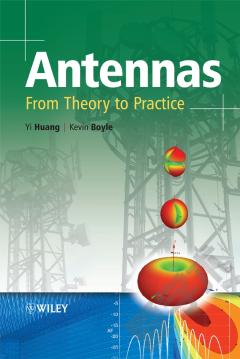Antennas —— From Theory to Practice
----- 天线 - 从理论到实践
Preface. List of Symbols. 1. Introduction. 1.1 A Short History of Antennas. 1.2 Radio Systems and Antennas. 1.3 Necessary Mathematics. 1.3.1 Complex Numbers. 1.3.2 Vectors and Vector Operation. 1.3.3 Coordinates. 1.4 Basics of Electromagnetics. 1.4.1 Electric Field. 1.4.2 Magnetic Field. 1.4.3 Maxwell's Equations. 1.4.4 Boundary Conditions. Summary. References. Problems. 2. Circuit Concepts and Transmission Lines. 2.1 Circuit Concepts. 2.1.1 Lumped and Distributed Element Systems. 2.2 Transmission Line Theory. 2.2.1 Transmission Line Model. 2.2.2 Solutions and Analysis. 2.2.3 Terminated Transmission Line. 2.3 The Smith Chart and Impedance Matching. 2.3.1 The Smith Chart. 2.3.2 Impedance Matching. 2.3.3 Quality Factor and Bandwidth. 2.4 Various Transmission Lines. 2.4.1 Two-wire Transmission Line. 2.4.2 Coaxial Cable. 2.4.3 Microstrip Line. 2.4.4 Stripline. 2.4.5 Co-planar Waveguide (CPW). 2.4.6 Waveguide. 2.5 Connectors. Summary. References. Problems. 3. Field Concepts and Radiowaves. 3.1 Wave Equation and Solutions. 3.1.1 Discussion on Wave Solutions. 3.2 Plane Wave, Intrinsic Impedance and Polarisation. 3.2.1 Plane Wave and Intrinsic Impedance. 3.2.2 Polarisation. 3.3 Radiowave Propagation Mechanisms. 3.3.1 Reflection and Transmission. 3.3.2 Diffraction and Huygens' Principle. 3.3.3 Scattering . 3.4 Radiowave Propagation Characteristics in Media. 3.4.1 Media Classification and Attenuation. 3.5 Radiowave Propagation Models. 3.5.1 Free Space Model. 3.5.2 Two-ray Model/Plane Earth Model. 3.5.3 Multipath Models. 3.6 Comparison of Circuit Concepts and Field Concepts. 3.6.1 Skin Depth. Summary. References. Problems. 4. Antenna Basics 125. 4.1 Antennas to Radiowaves. 4.1.1 Near Field and Far Field. 4.1.2 Antenna Parameters from the Field Point of View. 4.2 Antennas to Transmission Lines. 4.2.1 Antenna Parameters from the Circuit Point of View. Summary. References. Problems. 5. Popular Antennas. 5.1 Wire-Type Antennas. 5.1.1 Dipoles. 5.1.2 Monopoles and Image Theory. 5.1.3 Loops and Duality Principle. 5.1.4 Helical Antennas. 5.1.5 Yagi-Uda Antennas. 5.1.6 Log-periodic Antennas and Frequency Independent Antennas. 5.2 Aperture-Type Antennas. 5.2.1 Fourier Transform and Radiated Field. 5.2.2 Horn Antennas. 5.2.3 Reflector and Lens Antennas. 5.2.4 Slot Antennas and Babinet's Principle. 5.2.5 Microstrip Antennas. 5.3 Antenna arrays. 5.3.1 Basic Concept. 5.3.2 Isotropic Linear Arrays. 5.3.3 Pattern Multiplication Principle. 5.3.4 Element Mutual Coupling. 5.4 Some Practical Considerations. 5.4.1 Transmitting and Receiving Antennas: Reciprocity. 5.4.2 Balun and Impedance Matching. 5.4.3 Antenna Polarisation. 5.4.4 Radomes, Housings and Supporting Structures. Summary. References. Problems. 6. Computer Aided Antenna Design and Analysis. 6.1 Introduction. 6.2 Computational Electromagnetics for Antennas. 6.2.1 Method of Moments (MoM). 6.2.2 Finite Element Method (FEM). 6.2.3 Finite Difference Time Domain (FDTD) Method. 6.2.4 Transmission Line Modelling (TLM) Method. 6.2.5 Comparison of Numerical Methods. 6.2.6 High Frequency Methods. 6.3 Examples of Computer Aided Design and Analysis. 6.3.1 Wire-type Antenna Design and Analysis. 6.3.2 General Antenna Design and Analysis. Summary. References. Problems. 7. Antenna Manufacturing and Measurements. 7.1 Antenna Manufacturing. 7.1.1 Conducting Materials. 7.1.2 Dielectric Materials. 7.1.3 New Materials for Antennas. 7.2 Antenna Measurement Basics. 7.2.1 Scattering Parameters. 7.2.2 Network Analysers. 7.3 Impedance, S11, VSWR, and Return Loss. 7.4 Radiation Pattern Measurements. 7.4.1 Open Area Test Sites (OATS). 7.4.2 Anechoic Chambers. 7.4.3 Compact Antenna Test Ranges (CATR). 7.4.4 Planar and Cylindrical Near Field Chambers. 7.4.5 Spherical Near Field Chambers. 7.5 Gain Measurements. 7.5.1 Comparison with a Standard-gain Horn. 7.5.2 Two-antenna Measurement. 7.5.3 Three-antenna Measurement. 7.6 Miscellaneous Topics. 7.6.1 Efficiency Measurements. 7.6.2 Reverberation Chambers. 7.6.3 Impedance De-embedding Techniques. 7.6.4 Probe Array in Near Field Systems. Summary. References. Problems. 8. Special Topics. 8.1 Electrically Small Antennas. 8.1.1 The Basics and Impedance Bandwidth. Introduction. Slope Parameters. Impedance Bandwidth. Fundamental Limits of Antenna Size, Q and Efficiency. The Limits of Bandwidth Broadening. Discussions and Conclusions. 8.1.2 Antenna size reduction techniques. Top Loading. Matching. Reactive Loading. Dielectric Loading. 8.2 Mobile Antennas, Antenna Diversity and Human Body Effects. 8.2.1 Introduction. 8.2.2 Mobile Antennas. The Cellular Frequency Bands. The "Connectivity" Frequency Bands. Typical Antenna Types. a). Monopoles. b). Helical Antennas. c). Monopole-Like Antennas. d). Planar Inverted F Antennas. The Effect of the PCB. Specific Absorption Rate (SAR). Multipath and Mean Effective Gain. 8.2.3 Antenna Diversity. De-correlation Methods. a). Polarisation Diversity. b). Spatial Diversity. c). Radiation Pattern Diversity. Combining Methods. a). Switched Combining (SWC). b). Selection Combining (SC). c). Equal Gain (EGC). d). Maximal Ratio (MRC). The Effect of Branch Correlation. The Effect of Unequal Branch Powers. Examples of Diversity Antennas. MIMO Antennas. 8.2.4 User Interaction. Introduction. Body Materials. Typical Losses. 8.3 Multi-band and Ultra Wideband Antennas. 8.3.1 Introduction. 8.3.2 Multi-band Antennas. Techniques. a). Higher Order Resonances. b). Resonant Traps. c). Combined Resonant Structures. c). Parasitic Resonators. Examples. 8.3.3 Wideband Antennas. 8.4 RFID Antennas. 8.4.1 Introduction. 8.4.2 Near Field Systems. 8.4.3 Far Field Systems. 8.5 Reconfigurable Antennas. 8.5.1 Introduction. 8.5.2 Switch and Variable Component Technologies. 8.5.3 Resonant Mode Switching/Tuning. 8.5.4 Feed Network Switching/tuning. 8.5.5 Mechanical Reconfiguration. Summary. References. 9. Appendix. 9.1 Industry Standard Coaxial Cables. 9.2 Connectors. 9.3 Selection of Antenna Simulation Software on the Market.
{{comment.content}}








 京公网安备 11010802027623号
京公网安备 11010802027623号